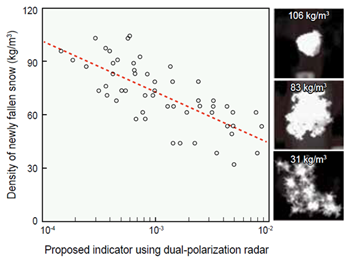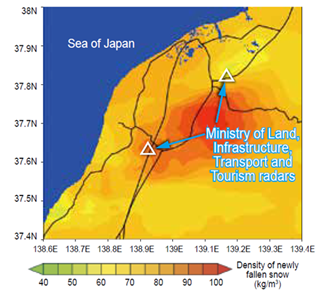27. Method for Estimating the Density of Newly Fallen Snow Using Dual-polarization Radar
An accurate understanding of snowfall depth is crucial for effective operations and snow removal planning. In recent years, the widespread use of polarization radar has enabled highly precise estimation of precipitation distribution. These radars can retrieve information about particle shapes by simultaneously transmitting and receiving horizontally and vertically polarized waves. However, determining the density of newly fallen snow—defined as the density of snow immediately after it has accumulated—is essential for estimating snowfall depth. This is because radars cannot directly estimate snowfall depth; they can only estimate the liquid-equivalent snowfall rate. Traditionally, ground-level air temperature has been used to estimate the density of newly fallen snow. However, this approach only accounts for snowmelt and does not correlate with the density of dry snow, which is primarily influenced by solid hydrometeor types (snowfall type, i.e. aggregate, graupel). To address this limitation, we developed a new method for estimating the density of newly fallen snow by incorporating snowfall types.
We proposed an index to quantify the similarity between observed snowfall types and graupel, based on analyses of radar data and in-situ snow particle observations. Figure 1 shows the relationship between the proposed index and the density of newly fallen snow. Using the empirical formula derived from this relationship, we can estimate the spatial distribution of new snow density in real time, while accounting for snowfall type (Figure 2).
By applying our method to estimate the density of newly fallen snow, improvements are expected in the accuracy of avalanche risk assessments, snowfall depth estimation on railway tracks, and evaluation of snow accretion under vehicle floors.
Other Contents
- 27. Method for Estimating the Density of Newly Fallen Snow Using Dual-polarization Radar
- 28. Prediction Method for Long-term Deformation Behavior of Concrete Bridges Considering Water Content Conditions
- 29. Non-contact Disc Brake Enabling Power Regeneration in Trailers
- 30. Method for Reducing Unstable Vibrations of Pantographs Caused by Sliding Friction
- 27. Method for Estimating the Density of Newly Fallen Snow Using Dual-polarization Radar
- 28. Prediction Method for Long-term Deformation Behavior of Concrete Bridges Considering Water Content Conditions
- 29. Non-contact Disc Brake Enabling Power Regeneration in Trailers
- 30. Method for Reducing Unstable Vibrations of Pantographs Caused by Sliding Friction


